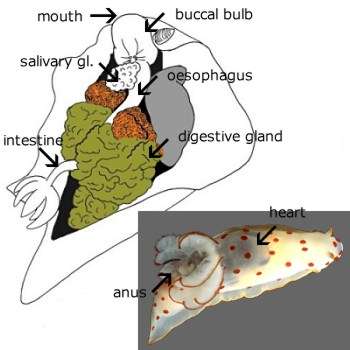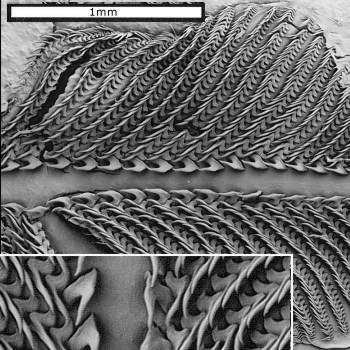

Digestive system of a dorid nudibranch
The best way to describe how the digestive system works in sea slugs is to describe a few examples. This is Gymnodoris ceylonica, a carnivorous hunter which Scott Johnson reports feeding on the small sea hare Stylocheilus. The structure and function of its gut is typical of most dorid nudibranchs, although there are slight modifications for feeding on different sorts of prey.
Have a look at the page on the dorid head to see where the mouth is and how they search for their prey. Inside the mouth is the muscular buccal bulb which contains the radula which is a ribbon of precisely arranged teeth used for scraping or grasping their food. A slug's teeth are not in jaws like us but on a flexible tongue. The bottom photo shows the radular ribbon of Gymnodoris removed from the buccal bulb and flattened out for easy viewing.
Most sea slugs have salivary glands which secrete digestive juices into the buccal bulb to help start the digestive process.
From the buccal bulb the food moves back through a tube called the oesophagus to the stomach, which in dorids is usually a fairly small chamber, with ducts leading off to the digestive gland.
If you look at the picture of Gymnodoris you will see a large black shadow in the body in front of the gills. This is the digestive gland. The arrow seems to be pointing to this, but is in fact pointing to the thin-walled heart which lies over the top of it. The digestive gland is a very important organ in all molluscs (snails, slugs, clams, octopus etc). It is the organ which produces most of the digestive enzymes, it absorbs all the nutrients, and excretes all the waste products. It does all the work of the stomach, intestine, and liver in humans.
Waste products, both non-food particles, which stay in the stomach and are not sent to the digestive gland, and waste material excreted by the digestive gland, are compacted into faecal pellets and travel through the intestine to the anus. In dorid nudibranchs, the anus is found in the centre of the gills. This may seem to be a strange place to deposit their faeces but have a look at the pages on Torsion and Detorsion which explain how snails became slugs and how their bodies changed as the shell was lost.
Authorship detailsRudman, W.B., 2000 (March 16) Digestive system of a dorid nudibranch. [In] Sea Slug Forum. Australian Museum, Sydney. Available from http://www.seaslugforum.net/find/dorigut
Related messages
Information needed urgently
June 30, 2000
From: Rachel Samuels
Hi I'm doing an assignment on nudibranchs and I have found all the information I need except a diagram of the internal structure. If you could send me a diagram or information on this it would be very much appreciated. Thanks,
Rachel Samuels
jamac@myoffice.net.au
Samuels, R., 2000 (Jun 30) Information needed urgently. [Message in] Sea Slug Forum. Australian Museum, Sydney. Available from http://www.seaslugforum.net/find/2615Dear Rachel,
The Forum is not really set up to do student assignments urgently. I suspect you haven't really got all the information you need if you think that one diagram will cover the internal structure of all nudibranchs. I am afraid that you would need 20 or 30 diagrams to cover the variation within the nudibranchs.
I am gradually adding information on aspects of their anatomy which you will find if you go to the list of General Topics. There is one page with a diagram showing the gut of a dorid nudibranch which could be useful, but that is only one of the body plans found in the Nudibranchia.
If you have access to a university library have a look at Mollusca - The Southern Synthesis which has a comprehensive section on opisthobranch anatomy.
Good Luck with your assignment,
Bill Rudman.
About a slug's digestive system
March 18, 2000
From: jessica
How does a slugs digestive system work?
jessica
score116@hotmail.com
Dear Jessica,
Sea Slugs feed on a wide variety of different foods. Some are herbivores, feeding on sea weeds and other marine plants and others are carnivores, each species feeding on very specific food items.
Their digestive systems have evolved different features to cater for the different foods they eat.
I have prepared a page for you on the digestive system of a dorid nudibranch which is a pretty good example of how a slug's digestive system works.
For more information have a look at the General Topics Index for interesting pages and use the Search Button for more information. Try searching for food or feeding, and perhaps for gizzard, because many sea slugs have a gizzard with crushing plates to 'chew up' their foodbefore it reaches the stomach.
Best wishes,
Bill Rudman.
